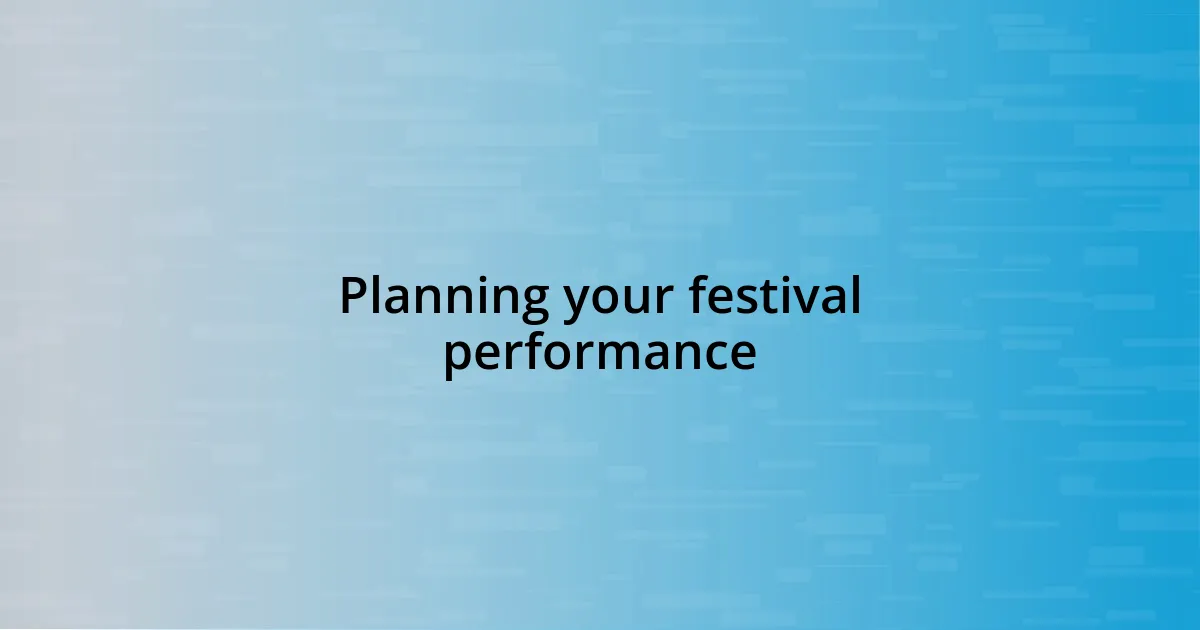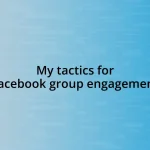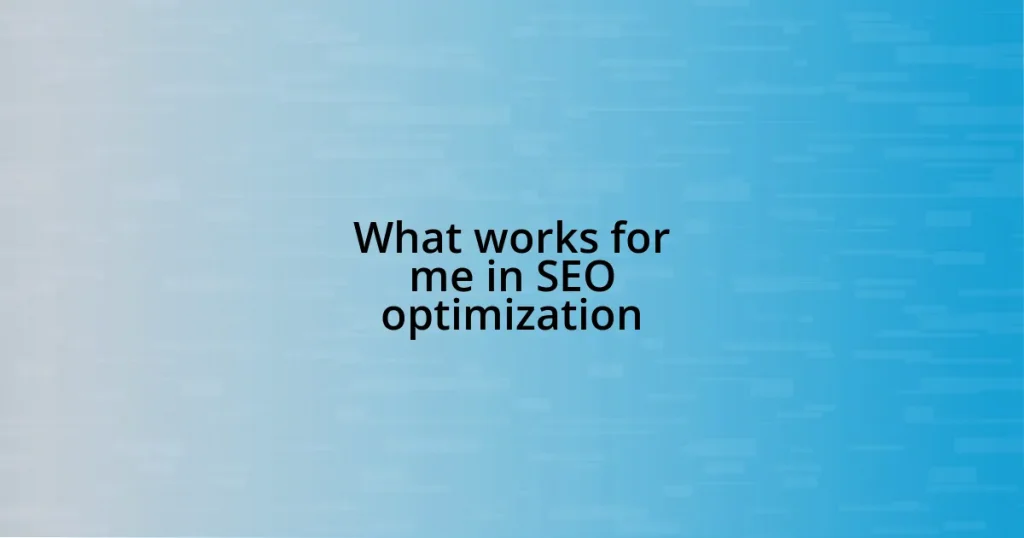Key takeaways:
- Effective festival promotions require deep audience understanding and tailored messaging to enhance engagement and create a communal celebration.
- Utilizing multiple platforms and storytelling in promotions can amplify reach and build a personal connection with attendees.
- Collaboration with local businesses enhances community spirit, supports local culture, and simplifies logistics for festivals.
- Evaluating promotional success through metrics and attendee feedback is crucial for refining strategies and improving future events.

Understanding festival performance promotions
Understanding festival performance promotions is a fascinating journey that blends creativity with strategy. I remember attending a local music festival where the artist lineup was promoted in such a vivid way, it felt almost personal. Each poster and social media post painted a picture that drew fans in, making them feel connected to the performers before the first note even played.
In my experience, effective promotion requires a deep understanding of the audience. I once witnessed a festival that tailored its marketing to the specific tastes and demographics of their attendees, which resulted in an electric atmosphere. I often wonder, how do the right messages resonate so powerfully? When the promotions speak to the heart of what fans love, it truly transforms the experience, turning attendance into a communal celebration.
Additionally, utilizing multiple platforms can amplify success. During one festival, I saw how coordinated efforts across social media, email marketing, and even local partnerships sparked immense interest. It made me realize—the more touchpoints we create, the stronger the bond with potential festival-goers. Have you ever felt an urge to attend an event just from the excitement radiating through its promotions? It’s a powerful reminder of how well-executed marketing can elevate an entire experience.

Planning your festival performance
When planning a festival performance, the first step is to envision the concept. I recall standing near the stage at a vibrant festival, watching the performers interact with the crowd. It made me realize that the atmosphere is everything. The performers’ energy resonated with the audience, creating an unforgettable connection. It’s essential to consider how you want your performance to feel—sparse and intimate or grand and explosive? This vision will guide every decision you make from the lineup to the staging.
Next, logistics play a critical role in executing your vision. I learned this the hard way while coordinating a set for a local festival where sound checks overlapped with other acts. The chaos was palpable, and it highlighted the importance of clear communication and organization. Having a detailed schedule and backup plans can prevent unnecessary stress. This ensures that each performer has their moment, and the audience can enjoy a seamless experience.
Lastly, marketing is vital when planning your performance. Drawing from my experience, I remember a festival that used storytelling in their promotions, showcasing performers’ journeys. It created a deeper connection with attendees, who felt they knew the artists on a personal level. Crafting a narrative around your performance can elevate anticipation and enhance the audience’s overall experience, making them feel part of something larger.
| Aspect | Consideration |
|---|---|
| Concept | Decide on the atmosphere and energy you wish to create. |
| Logistics | Ensure clear communication and detailed schedules for smooth operations. |
| Marketing | Use storytelling to engage the audience and elevate anticipation. |

Building a promotional strategy
Building a promotional strategy is like crafting a beautiful tapestry, where every thread contributes to the overall picture. I remember the thrill of collaborating with local artists to create unique content for one festival. We brainstormed ideas that resonated with the local culture and shared them across various social media channels. This collaborative effort not only strengthened our message but also engaged the community, making them feel involved in the festival’s success.
To develop a successful promotional strategy, consider these key elements:
- Audience Analysis: Understand who your audience is and what they love; tailor your messaging accordingly.
- Multi-Channel Promotion: Leverage various platforms like social media, email, and community events to expand your reach.
- Consistency is Key: Maintain a unified brand message across all channels to build recognition and trust.
- Engagement Tactics: Use interactive elements, like polls or contests, to actively involve your audience and enhance their anticipation.
- Feedback Loop: After the event, gather insights to refine future promotional strategies and keep the dialogue going with your audience.
Reflecting on my experiences emphasizes that a well-crafted promotional strategy can truly elevate the collective excitement around a festival. When everyone feels included, it transforms a simple event into a community celebration.

Engaging with your audience
When I think about engaging with your audience, I can’t help but recall a moment at a festival where the crowd erupted into cheers as the band invited them to sing along. It was incredible to witness that energy and connection. How do you create those moments? I believe it starts with sharing genuine interactions. Making eye contact, moving through the crowd, or even just responding to their enthusiasm can transform a performance into a shared experience.
Another strategy I learned was to involve the audience before the festival even begins. I remember running a social media campaign where we encouraged fans to share their favorite songs or memories related to the performers. The response was overwhelming. It wasn’t just about promoting the lineup; it was about cultivating a sense of belonging. This two-way conversation fosters excitement, making attendees more invested in the performance.
Lastly, I’ve discovered the power of storytelling during a set. Once, while performing, I shared a personal story behind a song. The audience leaned in, completely captivated. It was fascinating to see how vulnerability fostered connection. Isn’t it amazing how sharing a piece of ourselves can invite others into our world? Engaging with your audience isn’t just about entertaining them; it’s about creating a meaningful exchange that lingers long after the last note is played.

Leveraging social media channels
From my experience, leveraging social media channels became a game-changer in promoting festival performances. I vividly remember the excitement of setting up an Instagram story countdown for an upcoming festival. Each day, we posted sneak peeks of artists, captivating behind-the-scenes content, and even audience polls on what they anticipated most. The response was electric; it created a buzz that carried right into the festival gates.
One thing I learned is the importance of authenticity in social media posts. During one festival, I experimented with “day-in-the-life” videos showcasing not just the performances but also the dedicated team behind the scenes. I was surprised to see how much this resonated with our followers. They felt a connection with the people who worked tirelessly to create the event. It’s fascinating how transparency can enhance engagement. Have you ever thought about sharing the less glamorous moments? Following that approach can make your promotional content feel relatable and human.
Additionally, I found that using platform-specific strategies truly maximized our reach. For instance, we decided to create TikTok challenges related to the festival, encouraging fans to participate and share their dance moves. Each submission became a delightful snippet of our community’s creativity, multiplying our event’s visibility. Isn’t it incredible how a simple idea can spiral into a widespread movement? In my experience, embracing the unique features of each channel is crucial to capturing attention and fostering authentic connections.

Collaborating with local businesses
When I think about collaborating with local businesses for festival promotions, a memorable experience comes to mind. During one festival, I partnered with a beloved local coffee shop to offer free samples to attendees. The buzz around those aromatic brews not only enhanced the festival atmosphere but also drew in crowds eager to support their neighborhood favorites. It was a win-win! Have you ever noticed how local partnerships can elevate an event, fostering community spirit and excitement?
One of the aspects I truly enjoy is the creative synergy that emerges from these collaborations. A few years back, I teamed up with a unique local artist who crafted handmade merchandise for the festival. The connection she formed with attendees by sharing her process created an engaging storytelling aspect, making each item feel like a special treasure. It felt magical watching visitors connect with her passion and artistry. Isn’t it amazing how local collaborations can transform a simple festival into a celebration of community talent?
I’ve realized that these partnerships often simplify logistics as well. For instance, when sourcing food vendors for a festival, working with nearby restaurants allowed us to keep the culinary experience both fresh and local. I remember sampling vibrant dishes that not only delighted our taste buds but also sparked conversations about the flavors of our town. Collaborating with businesses fosters a sense of belonging, making the festival feel deeply rooted in the local culture. How do you think supporting local can change the dynamics of your events?

Evaluating your promotional success
Evaluating promotional success is crucial to understanding what resonates with your audience. I remember a particular festival where we closely tracked engagement metrics—likes, shares, and comments—to gauge our outreach efforts. Looking back, I was surprised to realize how much the audience’s feedback informed our strategy in real time. Did you ever think of metrics as more than just numbers but as a conversation about what your audience desires?
Another eye-opening experience came when I analyzed ticket sales data in conjunction with our promotional activities. It became clear that certain promotional tactics—like surprise guest reveals—generated spikes in sales. Those moments allowed me to see the direct correlation between effective marketing and tangible results. Have you considered how refining your promotional strategies can lead to better attendance?
Finally, I made it a point to survey attendees post-festival, asking them what drew them in. Some of their responses illuminated aspects I hadn’t even considered, like the impact of our community partnerships and relatable social media content. This feedback loop taught me a valuable lesson: understanding your audience will not only evaluate your success but also pave the way for future improvements. How can feedback shape the promotional landscape for your next event?















